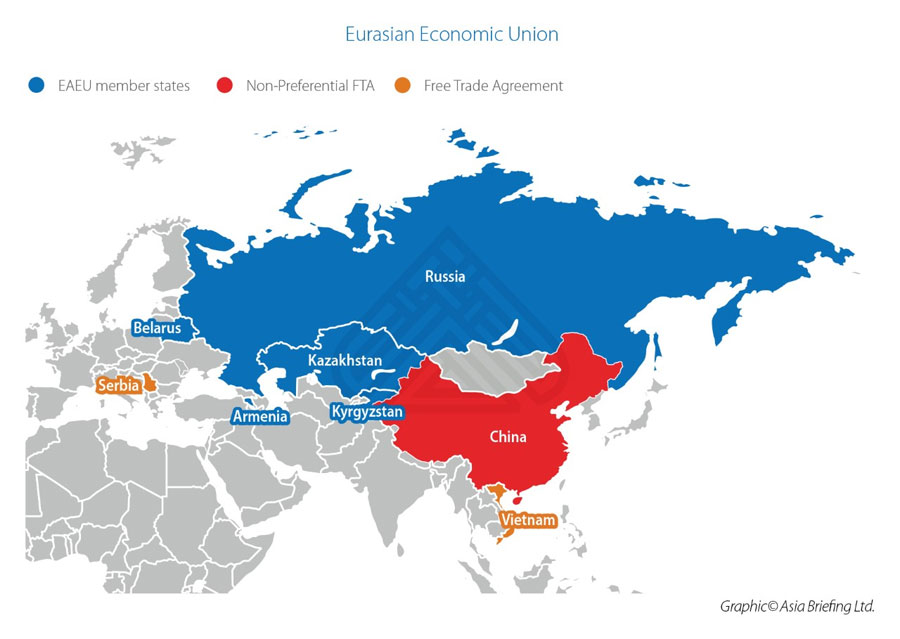Russia’s Eurasian Economic Union Free Trade Area Gets Its First Foothold In Europe
Op/Ed by Chris Devonshire-Ellis
China and Russia move in on EU as Brussels prevaricates
The Eurasian Economic Union, a free trade area that sits between the European Union and China, is about to gain inroads into Europe. Serbia, which borders EU members Hungary, Romania, Bulgaria, as well as Croatia, Bosnia & Herzegovina, Montenegro, Kosovo and North Macedonia, has agreed to sign of an FTA with the EAEU on 25th October.
This brings to an end the proposal for Serbia to join the European Union, which had been targeted for 2025, yet appeared subject to constant delays and moving accession targets from Brussels. Belgrade was further alienated from the EU when Brussels insisted on delaying a proposed Budapest-Belgrade rail line, financed by China, and insisted that as Hungary was an EU member, the evaluation and tendering processes fell under EU remit. This delayed the project for 3 years and came close to cancellation of the finance. Eventually, a Chinese consortium did win the bid and work is now underway. However the interference from Brussels on what the Serbs regarded as a sovereign project was not lost on Belgrade. The result has been a rupture in relations and the turning of Serbia to embrace the east in the form of the EAEU. Serbia has also signed off a Belt & Road MoU with China.
The EAEU is a trade bloc that includes Armenia, Belarus, Kazakhstan, Kyrgyzstan and Russia, a combined market with over 182 million consumers and an annual GDP of more than US$1.9 trillion. It shares borders with EU members Estonia, Finland, Latvia, Lithuania and Poland and to the East with the Western borders of China. China signed an FTA with the EAEU last year, although at this moment it is non-specific, meaning it has not yet specified as products that can be freely traded. However, China and EAEU member states are currently negotiating this point. As and when agreement on free trade and movement of Chinese goods with the EAEU occurs, Chinese products and services will be able to be landed on Ports right next to EU borders. Cities such as Brest and Minsk in Belarus especially are gearing up for this, with new infrastructure linking expanded airports, inland ports and development zones to service Chinese and EAEU products destined for EU markets. These are currently being put in place as I write.
The EAEU also has an FTA with ASEAN member Vietnam, and has seen Russian investment especially pour into the country. From a base of close to zero, Russian FDI into Vietnam has reached about US$10 billion in just two years as Moscow looks east to supply its consumer demands, currently under EU sanctions.
The addition of Serbia into the mix adds a European component to Russia and China’s Eurasian ambitions. With the Balkan countries nearby and Chinese ports in Greece, an eastern and southern springboard into the EU is now taking shape, especially as Brussels is regarded as constantly prevaricating in the region, with countries promised “connectivity” rather than trade agreements. It is that lack of clear EU strategy in Southern Europe, and the discontent felt by members over the treatment of Greece during its economic crisis, that is leading countries such as Serbia to look to Moscow and Beijing for trade and investment opportunities instead of Brussels.
Related Reading
- Serbia To Become Route Between Eurasia & Europe As It Signs Off EAEU Free Trade Deal
- The EU Commission’s View of China and the Belt and Road Initiative – The Map
- Russia and China’s Positioning Within The Belt & Road, Shanghai Cooperation Organization & Eurasian Economic Union
About Us
Silk Road Briefing is produced by Dezan Shira & Associates. The firm provides business intelligence, legal advisory, tax advisory and on-going legal, financial and business operational support to investors throughout China, India, ASEAN and Russia, and has 28 offices throughout the region. We also provide advice for Belt & Road project facilitation. To contact us please email silkroad@dezshira.com or visit us at www.dezshira.com






